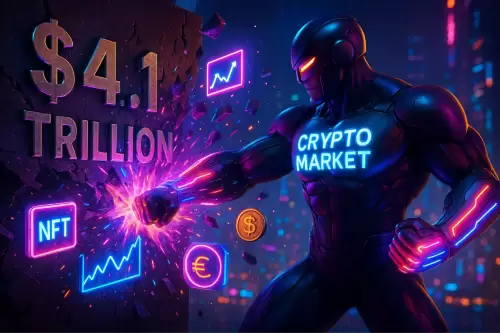 |
|
 |
|
 |
|
 |
|
 |
|
 |
|
 |
|
 |
|
 |
|
 |
|
 |
|
 |
|
 |
|
 |
|
 |
|
Cryptocurrency News Articles
Introducing Cardinal Protocol: The DeFi Protocol on Bitcoin
Jun 11, 2025 at 11:03 am
Bitcoin, the world's first cryptocurrency, has traditionally been limited in its programmability compared to other blockchain networks like Ethereum.

Bitcoin, the world’s first cryptocurrency, has traditionally been limited in its programmability compared to other blockchain networks like Ethereum. This difference arises from Bitcoin’s emphasis on minimal code changes and its lack of Turing-complete smart contracts. However, the introduction of the Cardinal Protocol by Cardano marks a groundbreaking shift, enabling Bitcoin to participate in decentralized finance (DeFi) without relying on custodians or federated systems. This innovation is made possible by combining Cardano’s smart contract capabilities with cross-chain technology.
Cardinal Protocol, developed by Input Output Global (IOG), focuses on unspent transaction outputs (UTXOs), which are the units of value in the Bitcoin blockchain. These UTXOs are transformed into programmable assets on the Cardano blockchain, maintaining the original Bitcoin’s security and allowing it to be used effectively in DeFi.
“We focused on combining the best of both blockchains to create a protocol that is both trust-minimized and capital-efficient,” says Sebastian Angel, Head of Special Projects at IOG. “This is in contrast to existing bridges, which either place too much trust in a small number of parties or are limited in the types of DeFi use cases they support.”
MuSig2 Multi-Signature Security
Cardinal employs MuSig2, an aggregated multi-signature scheme, to lock Bitcoin UTXOs on the Bitcoin base layer. This ensures that the original Bitcoin remains safe while enabling cross-chain functionality. The protocol also uses a rotating operator set and a framework for publishing fraud proofs in the event of operator misconduct.
On the Cardano side, the locked Bitcoin UTXOs are represented as 1:1-pegged non-fungible tokens (NFTs), which retain their on-chain provenance. This allows Ordinals, the new standard for programmable assets on Bitcoin, to circulate within DeFi markets without losing their historical data.
Users can redeem their wrapped Bitcoin at any time using the same multi-signature keys, providing flexibility and security. Moreover, Cardinal integrates BitVMX, an off-chain verifiable execution framework, to publish fraud proofs to Bitcoin in case of operator behavior deviating from the protocol rules.
This closely aligns the bridge’s security model with Bitcoin’s own, offering a trust-minimized alternative to existing federated solutions like wBTC.
Why Is Cardinal Protocol Significant for Bitcoin DeFi?
Trust-Minimized Design
Unlike custodial and federated bridges, Cardinal’s MuSig2 model reduces the trust surface while maintaining capital efficiency. This design eliminates risks such as rehypothecation, where custodians reuse user assets without transparency, and operational risks associated with single points of failure.
Expanded Use Cases for Bitcoin
With Cardinal, Bitcoin holders can now:
* Participate in automated market maker (AMM) pools.
* Lend and borrow assets for yield generation.
* Use Ordinals as collateral for loans.
* Auction or trade Bitcoin-based assets across chains.
This opens up a new chapter for Bitcoin in the rapidly evolving DeFi landscape.
Enhanced Security and Efficiency
Cardano’s eUTXO accounting system closely mirrors Bitcoin’s UTXO structure, simplifying equivalence proofs for symmetric pegs. Additionally, deterministic transaction costs and low fee volatility make the protocol more predictable and user-friendly, especially for DeFi applications.
Challenges and Future Developments
While Cardinal Protocol is a significant milestone, it is not yet a turnkey consumer product. The following areas require further development:
* Technical Enhancements
* Improved SNARK-based burn-proof generation.
* Recursive state proofs for better scalability.
* Enhanced wallet UX.
* Independent Audits
* The MuSig2 implementation and operator rotation logic need rigorous scrutiny to ensure robustness against potential exploits.
* Liquidity Growth
* Cardano’s TVL has seen fluctuations, but the team remains optimistic about attracting new liquidity from Bitcoin.
How Does Cardinal Compare to Other Bitcoin DeFi Solutions?
Cardinal stands out due to its trust-minimized approach and integration with Cardano’s smart contracts. Unlike traditional wrapped Bitcoin solutions, which rely on centralized custodians, Cardinal ensures that users retain full control over their assets. This innovation addresses long-standing concerns about security and transparency in the Bitcoin DeFi ecosystem.
Despite the technical challenges involved in bridging two distinct blockchain networks, institutions and developers are increasingly exploring cross-chain protocols to connect different blockchains and expand the possibilities of decentralized technologies.
Disclaimer:info@kdj.com
The information provided is not trading advice. kdj.com does not assume any responsibility for any investments made based on the information provided in this article. Cryptocurrencies are highly volatile and it is highly recommended that you invest with caution after thorough research!
If you believe that the content used on this website infringes your copyright, please contact us immediately (info@kdj.com) and we will delete it promptly.






























































